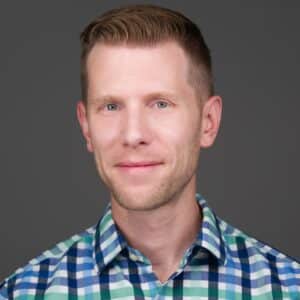At LeanTaaS, our mission to transform healthcare operations is driven by the talented people behind the technology. Mission in Motion is a new blog series that introduces the team members whose expertise, creativity, and personal journeys inspire the work we do every day. Through their stories, we’ll explore what motivates them to tackle some of healthcare’s toughest operational challenges and why this work matters so deeply.

In this first installment, we sit down with Chief Technology Officer Tim Vasil, whose decades of experience in data science and engineering have shaped LeanTaaS’ AI-driven solutions for hospital efficiency and patient care. Tim co-founded Hospital IQ in 2013 to address inefficiencies in hospital workflows, and after its acquisition by LeanTaaS in 2022, he took on a progression of leadership roles that shaped the company’s technology strategy. Now, as Chief Technology Officer, Tim is focused on advancing AI-driven solutions that improve hospital efficiency, enhance patient care, and support healthcare staff.
What initially sparked your interest in data science, particularly in the healthcare industry?
Tim Vasil: My introduction to healthcare was accidental. In grad school at MIT, I worked on a project for the Beth Israel Spine Center but didn’t think much of it at the time. I was happy building social networking apps at Google, enjoying the craft of engineering.
That changed when my future Hospital IQ co-founder, Rich Krueger, reached out and said, ‘Hey, I saw you did this healthcare work—let’s dive into this space.’ I hadn’t considered healthcare professionally, but that shifted when I visited hospitals and saw staff managing operations with whiteboards and handwritten notes, doing complex scheduling in their heads. It was eye-opening.
As an engineer, my instinct was, ‘There’s got to be a better way.’ For the first time, I saw how my skills could solve meaningful problems. I was hooked.
Interacting with the healthcare system is an experience we all share. Have you had personal experiences that reinforced the importance of LeanTaaS’ mission?
TV: One of the most personal experiences was when my husband had to go to the emergency room with acute stomach pain. It turned out to be appendicitis, and watching him go through the system was frustrating. There were delays, miscommunications, long wait times—and when he was ready for discharge, nothing happened. We sat there, waiting, with no real visibility into why. Eventually, he ended up getting sicker, likely from being in the hospital too long.
I had a completely different experience at a different hospital with the same condition. When I had appendicitis, I went to the emergency department at 11:30 PM. By the next morning, I was out of surgery, recovered in the PACU, and in an Uber home—less than 11 hours total.
That contrast made it clear: hospital efficiency isn’t just about numbers—it impacts real lives. Key operational changes, like streamlining discharges, can significantly improve patient outcomes and quality of life.
How has AI transformed healthcare operations over the last decade, and how do you see the role of human expertise evolving?
TV: AI has gone from a buzzword to a necessity, but at LeanTaaS, we’ve been using AI-driven predictions and prescriptions for years—long before many in the industry fully understood their impact.
Early on, we built predictive models for patient flow, length of stay, and resource allocation, but customers didn’t always know how to act on those insights. That’s where prescriptive AI came in—helping hospitals not just forecast problems, but take proactive steps to solve them.
Today, expectations around AI have changed. Customers now demand AI-driven decision-making and are asking deeper questions about accuracy, bias, and governance. That shift is a sign of progress, as hospitals increasingly recognize the power of these tools.
But one thing remains the same: AI isn’t replacing humans; it’s empowering them. Hospitals are complex, human-driven environments. AI’s role is to deliver better, faster insights—so frontline teams can make the best possible decisions.
What is one major challenge in the health tech space?
TV: Data silos are a big hurdle. Hospitals sit on a wealth of data, but getting access to it can be difficult. Electronic medical record vendors have a strong grip on that information, making it difficult to extract and share—even when legislation is pushing for interoperability.
The irony is that digitizing health records was supposed to make everything more efficient. Instead, it’s created layers of inefficiency. Valuable insights are locked away, requiring workarounds to access.
This isn’t a technical problem—it’s a structural one. And until we break down these silos, hospitals won’t be able to fully leverage AI and predictive analytics to improve patient care and operations.
As the newly appointed CTO at LeanTaaS, how has your role evolved over time?
TV: It’s a balance of strategy and hands-on work. As CTO, I’m responsible for the long-term vision—shaping our technology to support an integrated, AI-driven efficiency platform for healthcare. Historically, we’ve been focused on siloed solutions. Now, we’re unlocking even more value by merging them into a platform.
At the same time, I still like to get into the technical weeds. I work closely with teams, help debug, and contribute to architecture decisions. I’m not a ‘stay in the boardroom’ kind of CTO. If something isn’t working, I’ll roll up my sleeves and help fix it.
That mix—vision-setting while staying connected to the work—feels like the right approach for where we are now.
How would you describe your leadership style?
TV: I focus on trust, autonomy, and letting people work on what excites them. One of my core beliefs is that people do their best work when they’re engaged. If someone wants to branch out—say a front-end engineer wants to learn back-end development—I encourage it. I’ve never liked rigid job descriptions that box people in.
I’ve also learned to step back. Earlier in my career, I micromanaged more than I should have. Over time, I realized that giving people ownership and responsibility leads to better outcomes. You hire great people, you trust them, and you give them space to grow.
What is one thing that you want readers to know about your team?
TV: This is a mission-driven team. We’re not just engineers building software—we’re solving real-world problems that impact patients and healthcare workers every day.
There’s also a strong culture of collaboration at LeanTaaS. People here challenge each other, support each other, and genuinely care about the work. It’s a team that believes in what we’re doing, and that makes all the difference.
Keep tabs on what Tim is up to by following him on LinkedIn.




